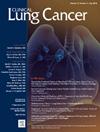放射医师与基于人工智能的软件:在各种图像显示条件下通过 CT 预测肺腺癌的淋巴结转移和预后
IF 3.3
3区 医学
Q2 ONCOLOGY
引用次数: 0
摘要
目的:比较在不同显示条件下由两名放射科医生和人工智能软件独立评估的肺腺癌 CT 图像定量值的变异性,并确定病理淋巴结转移(LNM)、无病生存(DFS)和总生存(OS)的预测因素:方法:307 名患者的术前 CT 图像在 4 种条件下显示:肺-1、肺-2、纵隔-1 和纵隔-2。两名放射科医生(R1、R2)分别测量了每种情况下的总直径(tD)和最长实体直径(sD)。基于人工智能的软件自动检测肺结节,并提供 tD、sD、总体积(tV)和实变体积(sV):R1 和 R2 使用人工智能软件进行的所有测量结果均相同。在 8 项测量中,有 4 项在 R1 和 R2 之间存在显著差异。对于 LNM,多变量逻辑回归确定的重要指标包括 R1 纵隔-2 的 sD、R2 纵隔-1 和纵隔-2 的 sD、tV 以及基于 AI 软件的 sV 与 tV 的比例(sV/tV)。对于 DFS,多变量 Cox 回归确定 R1 肺-1 的 sD、R1 肺-2 的 sD 与 tD 的比例、R2 肺-2 和纵隔-1 的 sD、tV 和基于 AI 软件的 sV/tV 具有显著性。对于 OS,多变量 Cox 回归确定基于 AI 软件的 R1 肺-1 和纵隔-2 的 sD、R2 肺-2 的 tD、R2 纵隔-1 的 sD、sV 和 sV/tV 具有显著性:结论:放射科医生的 CT 测量结果可显著预测 LNM 和预后,但放射科医生和显示条件之间存在差异。基于人工智能的软件可为预测 LNM 和预后提供准确且可重复的指标。本文章由计算机程序翻译,如有差异,请以英文原文为准。
Radiologists Versus AI-Based Software: Predicting Lymph Node Metastasis and Prognosis in Lung Adenocarcinoma From CT Under Various Image Display Conditions
Purpose
To compare the variability of quantitative values from lung adenocarcinoma CT images independently assessed by 2 radiologists and AI-based software under different display conditions, and to identify predictors of pathological lymph node metastasis (LNM), disease-free survival (DFS), and overall survival (OS).
Methods
Preoperative CT images of 307 patients were displayed under 4 conditions: lung-1, lung-2, mediastinum-1, and mediastinum-2. Two radiologists (R1, R2) measured total diameter (tD) and the longest solid diameter (sD) under each condition. The AI-based software automatically detected lung nodules, providing tD, sD, total volume (tV), and solid volume (sV).
Results
All measurements by R1 and R2 with AI-based software were identical. Four out of the 8 measurements showed significant variation between R1 and R2. For LNM, multivariate logistic regression identified significant indicators including sD at mediastinum-2 of R1, sD at mediastinum-1 and mediastinum-2 of R2, tV, and the proportion of sV to tV (sV/tV) of AI-based software. For DFS, multivariate Cox regression identified sD at lung-1 of R1, the proportions of sD to tD at lung-2 of R1, sD at lung-2 and mediastinum-1 of R2, tV, and sV/tV of AI-based software as significant. For OS, multivariate Cox regression identified sD at lung-1 and mediastinum-2 of R1, tD at lung-2 of R2, sD at mediastinum-1 of R2, sV, and sV/tV of AI-based software as significant.
Conclusion
Radiologists’ CT measurements were significant predictors of LNM and prognosis, but variability existed among radiologists and display conditions. AI-based software can provide accurate and reproducible indicators for predicting LNM and prognosis.
求助全文
通过发布文献求助,成功后即可免费获取论文全文。
去求助
来源期刊

Clinical lung cancer
医学-肿瘤学
CiteScore
7.00
自引率
2.80%
发文量
159
审稿时长
24 days
期刊介绍:
Clinical Lung Cancer is a peer-reviewed bimonthly journal that publishes original articles describing various aspects of clinical and translational research of lung cancer. Clinical Lung Cancer is devoted to articles on detection, diagnosis, prevention, and treatment of lung cancer. The main emphasis is on recent scientific developments in all areas related to lung cancer. Specific areas of interest include clinical research and mechanistic approaches; drug sensitivity and resistance; gene and antisense therapy; pathology, markers, and prognostic indicators; chemoprevention strategies; multimodality therapy; and integration of various approaches.
 求助内容:
求助内容: 应助结果提醒方式:
应助结果提醒方式:


